 The Arrow, the student newspaper at Southeast Missouri State University, is one of the longest-standing student-run newspapers in the country, with a proud history and tradition that has shaped the lives of its staff, the University and its readers for more than 100 years.
The Arrow, the student newspaper at Southeast Missouri State University, is one of the longest-standing student-run newspapers in the country, with a proud history and tradition that has shaped the lives of its staff, the University and its readers for more than 100 years.
From its first black and white printed edition on Feb. 1, 1911 then named the Capaha Arrow to todays full color print edition and digital website, now known as the Arrow, the newspaper has showcased the news of the campus and local and world events, while fostering journalism standards and launching extraordinary careers of talented and hardworking student reporters and editors.
Telling the stories – on and off campus
Throughout its history, the Arrow and its staff have tackled important and difficult issues on and off campus — from military conflicts, including World Wars I and II and the controversies of the Vietnam War, to uncovering flaws in voting procedures for Student Government elections in 1975.
For Mark Bliss, a 1976 Southeast graduate and now senior reporter covering government at the Southeast Missourian, he says his college days as a staff writer and then managing editor were inspired by the importance and popularity of national newspapers and reporters investigating and exposing the wrongs of society and government.
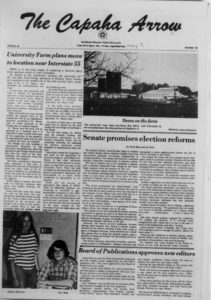
Southeast alumnus Mark Bliss’ story about the voting procedures for Student Government appears on the front page of the Arrow on May 7, 1976.
It was the heyday of newspapers, with Watergate and reporters capturing headlines and movie characters, said Bliss, who turned that investigative zeal into his own reporting and with fellow Arrow staff members began examining flaws in voting procedures for Student Government. We wanted to show we could vote at multiple voting locations on campus. Our premise, which proved correct, was that a student could vote at more than one polling place because the students manning the polls around campus were not checking to see if people had voted more than once.
He and his fellow reporters wanted to test their theory without affecting the voting results. Instead of selecting candidates, Arrow staffers wrote TESBI for This Election Should Be Invalidated on their ballots which they cast in multiple campus locations.
Their expos was noticed by the Southeast Missourian, which not only highlighted the controversy but also how the staff conducted their investigation and epitomized journalism standards, Bliss said.
Even when the issues were personal, the Arrow fostered a culture of innovation while tackling the tough subjects.
Dr. Tamara Buck, a 2000 graduate and now faculty advisor to the Arrow and multimedia journalism coordinator in the Department of Mass Media, said working at the Arrow was something she believed was not only her calling but also important for the campus community.
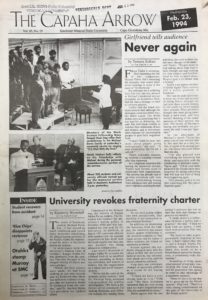
Southeast alumna Dr. Tamara Buck’s story about Michael Davis appears on the front page of the Arrow on Feb. 23, 1994.
We covered everything on campus. It didnt matter what it was, said Buck, who started as a staff writer and became the Arrows first African-American editor in 1994. I noticed that we werent covering a lot of diversity issues and events, and we changed our focus to include these. Being able to cover news culturally that was important to me and to many in the campus community was a big, significant step.
In February 1994, student and Arrow staff writer Michael Davis died as the result of a hazing incident. That time stands out in Bucks mind to this day, not only because Davis was a friend and colleague, but also because the issues she and her fellow staff members had to cover during this time were tragic.
It was difficult, Buck said. My community was being scrutinized, and the feelings and hurt from everything, and I remember putting that aside and being a professional journalist. We were covering real news, national news, and we didnt treat this as a club or social activity, but we were real professionals in our minds.
Gabe Hartwig, 2012 graduate and now deputy features editor at Go! Magazine and STL Life at the St. Louis Post-Dispatch, said being an Arrow editor was an incredible learning experience, especially during and after the terrorist attacks of Sept. 11, 2001.
Even though the attacks had happened on the East Coast, and were being covered extensively by national media, we found ways to make the stories relevant to our campus and local community, Hartwig said. We wrote lots of great stories for weeks to come safety, grieving, gas prices, military service. That experience gave our staff a chance to expand their skills and move beyond their usual beats.
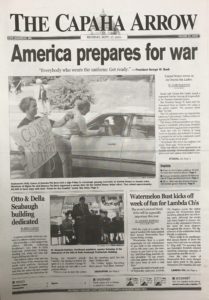
Southeast alumnus Gabe Hartwig’s story about the Sept. 11 terrorist attacks appears on the front page of the Arrow on Sept. 17, 2001.
The Arrow continues to never shy away from difficult topics with recent special issues on the 2016 election, sexual assault and the opioid crisis facing southeast Missouri.
An evolving look
While its mission and dedication to telling the story has remained at the forefront, the Arrows appearance in delivering its stories has evolved over the years with its staff always looking for new techniques and technology. Its first editions appeared as a cover page and had two columns of text. By 1916, the paper expanded to four columns, and five columns in 1925. Until 1937, the paper relied on photographs supplied from the Universitys yearbook the Sagamore, but later added a photographer to its staff to capture up-to-date images to correspond with its news. In 1976, students wrote their stories on typewriters, used layout sheets to mark where stories would be placed, and black and white photographs were hand sized and fit.
In 1988, then managing editor and soon-to-be editor Karie Hall, now Dr. Karie Hollerbach, professor of mass media at Southeast, recognized a new change was needed. The Arrow needed a new look, and it needed the right equipment to make this happen.
The Arrow had recently won four Missouri College Newspaper Association (MCNA) awards and would be hosting the next MCNA conference for the first time at Southeast. Hollerbach and her team came up with the idea to sell ads to fund a trip to the National Associated Collegiate Press conference in Washington, D.C., that summer. There they could focus on new ideas and new designs, said Hollerbach.
We were influenced by USA TODAY, which was new in 1983, but was really big by 1987, she said. We took workshops in design and took what wed learned back to campus. It really was a team effort to revamp the design, look, mission and administration of the Arrow.
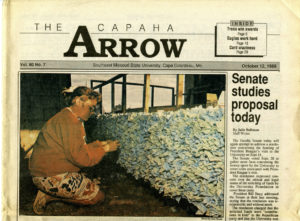
As editor for the Arrow between 1988-1989, Southeast alumna Dr. Karie Hollerbach helped redesign the student paper’s look, including printing colored photographs and ads.
That same year, Hollerbachs proposal to get the Arrow new Macintosh computers was approved by the department chair, dean and provost. That year the Arrow also began printing full-color photos and advertising.
Luck, opportunity and hard work all met that magical year from 1988 to 1989, Hollerbach said. The Arrows staff grew with a talented and diverse group; we had new computers; we were hosting the MCNA conference for the first time. We had a new design and new ideas. On top of all this, the University was visited by then President Ronald Reagan, the mens basketball team was having a winning season and the Show Me Center was brand new with great concerts and talent visiting campus.
Because of its hard work and dedication, in 1989, the Arrow won Best College Student Newspaper in Missouri, and 19 individual awards from the Missouri College Newspaper Association (MCNA), and Hollerbach won the MCNA award for Journalist of the Year.
In 2005, the paper changed its name from the Capaha Arrow to the Arrow as the University also evolved, transitioning its athletic team nickname to the Redhawks. With its new name, the Arrow also adopted a new masthead, the look of which evolved several times over the course of that year.
New curriculum, a new partnership, a new home
The Arrow and its staff continue to receive state and national recognition. It has won dozens of awards over the past three years, most recently receiving a first-place Writing Pinnacle, first-place Best of Collegiate Design Pinnacle and third-place Organizational Pinnacle at the Associated College Press (ACP)/College Media Association (CMA) 2018 Fall National College Media Convention.
A new curriculum in 2009, a partnership with Rust Communications in 2011, and a new space in the Rust Center for Media opening in 2016 has allowed the newspaper and students to continue growing, and their work is reflected in the recent awards and recognitions, Buck said.
I think it was the combination of multimedia curriculum, intentional experiential learning in and out of the classroom and a new facility dedicated to student success and journalism quality that has allowed the Arrow to evolve once again, Buck said. We have a broader group of people who are working with the publication on a regular basis, and I think thats really ramped up the quality.
The partnership forged with Rust Communications in 2011 revised the Arrows structure, and with that came an agreement with the Southeast Missourian to provide oversight of the Arrows print publication as well as more robust student-produced news website.
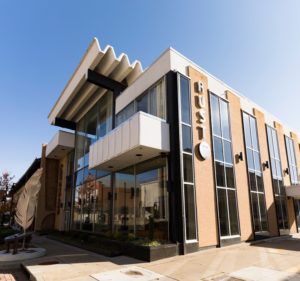
The Arrow is now housed in the Rust Center for Media at 325 Broadway in the Cape Girardeau media district.
This relationship also played an important role in the reaccreditation of Southeasts mass media program. Southeast is one of only two programs in Missouri and 119 journalism and mass communication programs nationally accredited by the Accrediting Council on Education in Journalism and Mass Communication (ACEJMC). The department first received ACEJMC accreditation in 2005 and was reaccredited in 2013 and 2017.
Under the partnership, Southeast entered into a lease agreement with Rust Communications for 12,000 square feet on two floors of a building owned by Rust Communications at 325 Broadway, now known as the Rust Center for Media.
The partnership with Rust Communications and the Southeast Missourian has greatly impacted the quality and relit the spirit of innovation and pride at the Arrow, Hollerbach said.
Prior to the Arrow being housed at the Rust Center for Media, it had many other homes on campus, including in Academic Hall, University-owned houses, and Grauel Building named for Southeast English professor and 1934-1937 Capaha Arrow Advisor Harold Grauel.
Its current home, the Rust Center for Media, features 6,300 square feet of space on the main floor with a flexible learning space as well as production studios for students enrolled in television directing and advanced video production. The lower level contains 6,700 square feet and houses the Arrow. There are workspaces for audio production, podcasting, photo production, webcast production and content creation. The floorplan encourages teamwork among students and faculty as well as the ability to connect multiple digital devices to each other as well as to TV monitors.
The Arrow has its own real home, and its not just in the classroom, but a dedicated space designed for the paper and the students, Buck said.
The Center is also located at a pivotal point in the Cape Girardeau media district that includes the Southeast Missourian newspaper and rustmedia next door and KFVS12 and River Radio across the street.
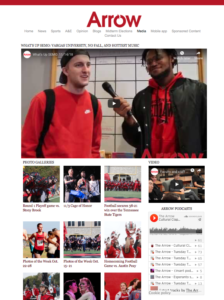
As part of its Digital First mission, the Arrow is focused on telling the story on every communication platform, from print, online and video to social media and a mobile app.
The students can seek and get advice from the professionals right next door and see how theyre handling some of the same issues, Buck said.
As part of its most recent evolution, the Arrow now publishes a print edition bi-weekly and has embraced a Digital First mission by focusing on telling the story on every communication platform, from print, online and video to social media and a mobile app.
The Arrow has been home to thousands of Southeast journalism students, and the skills and knowledge they gained have had lifelong impacts.
I learned a lot working there, and at the time, real-life experiences were important when looking for a career, Bliss said. It was really critical you had real-life experiences, and that was key for me to be able to do that.
Hollerbach agreed, saying, At the Arrow, I learned even more outside the classroom, from writing to management of a staff and deadlines. I always encourage students no matter their degree option to consider working at the Arrow. Ive seen the benefits, and it is worth the sacrifice because its only going to pay back in a very big way.
Our staff was fairly small, so we all pitched in and worked the late hours on production night. I think that really helped me become the manager I am today willing to do whatever it takes to get the job done and produce something we can all be proud of, said Hartwig.
And no matter how the Arrow reports the news, its importance at Southeast will always remain the same.
Student newspapers are important in the same way local newspapers are important — they provide the kinds of coverage that consumers won’t get anywhere else especially as professional newsrooms continue to shrink and downsize, and smaller stories often slip through the cracks, Hartwig said. And just as professional journalists are a check on power for governmental bodies, student journalists can hold officials accountable and provide a voice for their campus readers.